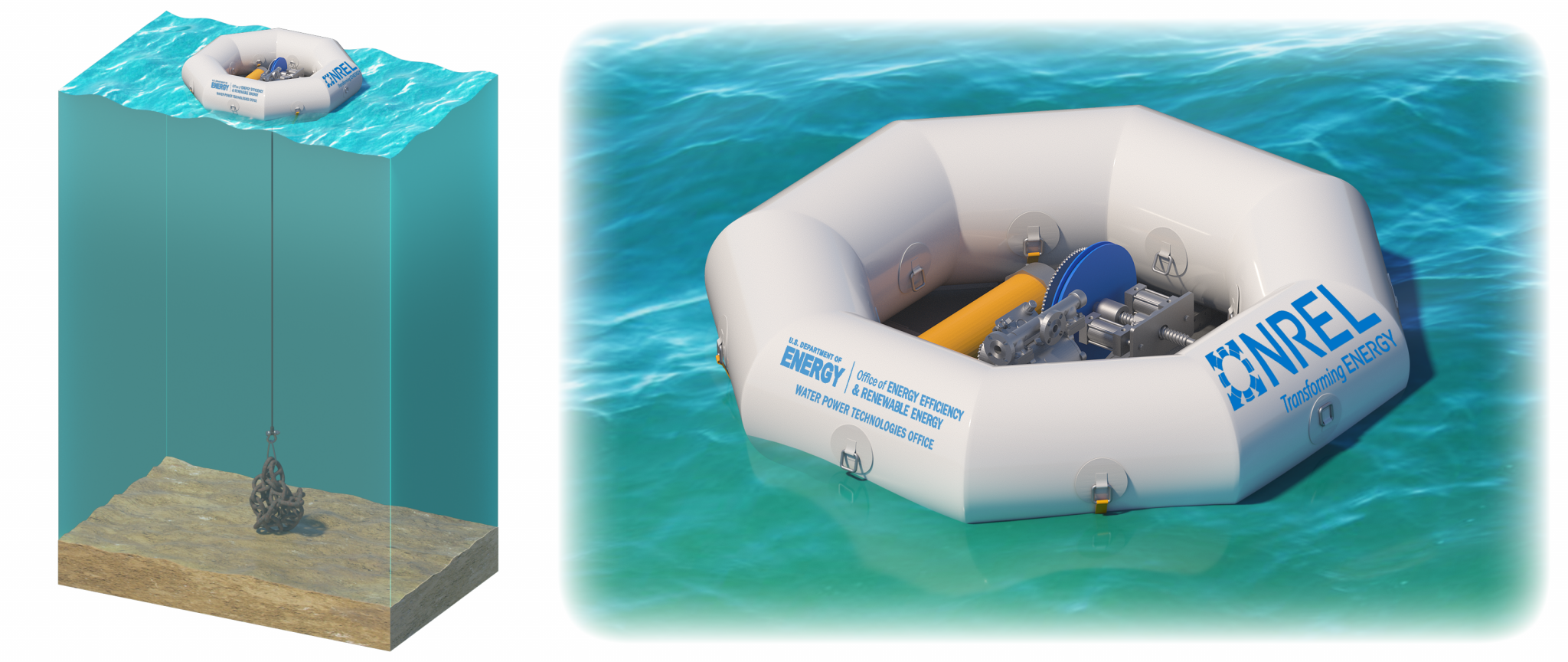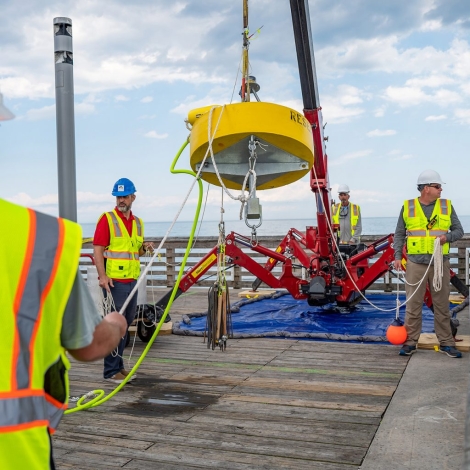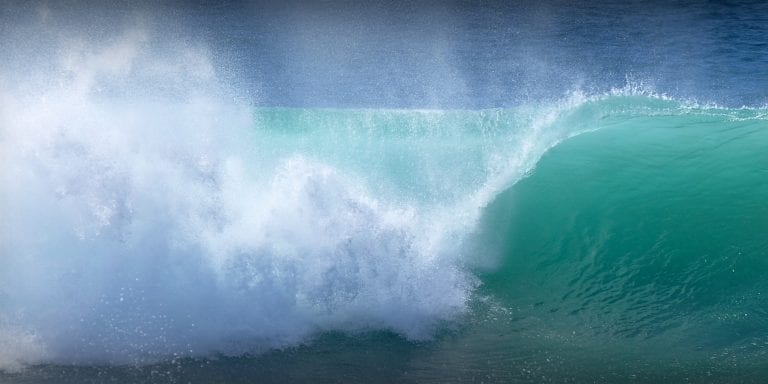Ten competitors in the Waves to Water Prize are advancing emerging technologies to innovate portable wave-powered desalination devices. The designs are as yet untested, the contest’s rules are focused, and the obstacles high. These are advantages and pitfalls confronting the design teams.
Powering the desalination of seawater with wave power makes a kind of intuitive sense. Place the device that separates salt from water next to its power source and let the ocean do the work. But, while the idea may be poetic, the details are puzzling. Wave-powered desalination has not yet progressed meaningfully beyond small-scale devices. The US National Renewable Energy Laboratory is attempting to kickstart progress with its Waves to Water Prize. NREL and the US Department of Energy are offering (USD) $3.3 million in prizes over the course of five stages. Now at the close of the fourth stage, 10 teams are building prototypes, competing for a share of a $500,000 pool that will be awarded to up to seven finalists.
Their ideas and their creations are advancing our understanding of what is possible in this technology. When finished, the teams’ prototypes will enter the water and generate new performance data for an emerging technology that still has few real-world exemplars. The hope to spur the development of future wave-powered desalination systems that can quickly deploy to coastal and island communities, especially during emergencies.
“I look at this problem as probably two or three major challenges and an infinite number of other challenges. There’s a reason they haven’t commercialized it, yet,” Scott Jenne, Research Engineer in Water Power Technologies at NREL told E4C.
Two wave energy paths: Direct their mechanical power or convert them into electricity?
That tradeoffs are tied to any given decision is a refrain heard often among designers of a wave-energy desalination system. One of the early decisions the design teams have had to make is between mechanical power or electricity. The mechanical motion of the waves can be harnessed directly to do the work of desalination, or that movement can be converted into electricity to power an electrical system. There are advantages and drawbacks to both.
Mechanical systems can be simpler, cost less and parts are more readily available. Seven of the 10 teams competing have opted for such a design. Electrical systems require more parts, including sensors, processors, and batteries. But they have advantages, and a big one is they can make electricity to power other things.
Another debate between electric and mechanical systems centers on the superiority of power cables versus hose.
“Each have different cost implications, efficiency losses, safety concerns (high pressure or high voltage), etc. So, teams have had to balance these considerations when developing their prototypes,” Mr. Jenne says.

NREL engineers are building a test device that will look something like the rendering pictured here. The Hydraulic and Electric Reverse Osmosis system, so-named to create the acronym HERO, is a wave-energy converter built to the rules laid down by the Waves to Water challenge. This device will help judges practice deploying the competitors’ prototypes and validate their measurements. For more see Charting the Course.
Challenge: Integrate wave power with reverse osmosis
This article will examine challenges the majority of the contestants are working to overcome while developing mechanical wave energy systems. One of which is how to operate a reverse osmosis system using the mechanical motion of the waves.
Reverse osmosis is the state of the art in desalination technology at the moment. As a quick recap, reverse osmosis applies pressure to a solution such as salty seawater on one side of a semi-permeable membrane, forcing it to pass through the membrane and leave behind salt and other solutes. The force applied must overcome and reverse natural osmotic pressure. Given the chance, pure water will pass through a semi-permeable membrane moving toward salt water, a phenomenon called osmosis. Reverse osmosis redirects the traffic. The technology is known, tested and bought off the shelf in a range of sizes.
“RO is hard to beat right now. It’s one of the most efficient methods of extracting salt from seawater. It’s also readily available. You can just go buy the membrane. You’re not trying to reinvent the system,” Mr. Jenne says. “It’s a known technology, it’s an accessible technology and it’s a pretty efficient technology.”
“RO is hard to beat right now. It’s one of the most efficient methods of extracting salt from seawater.”
The problem is how to integrate it with mechanical wave power. The force that each wave generates is unpredictable, and reverse osmosis systems need steady pressure. The power from waves is too chaotic for the devices to perform correctly. Small waves can’t create enough pressure to push water through the membrane, and large waves risk breaking the machine .
Mr. Jenne and colleagues have explored solutions to the problem and published some of their findings in the proceedings of the 36th International Conference on Ocean, Offshore and Arctic Engineering by the American Society of Mechanical Engineers.
The researchers examined two methods for regulating the lows and highs of mechanical wave power: accumulators and pressure-relief valves. Accumulators direct the motion of the waves to compress a gas such as air in a container. The gas can pick up slack when waves are too small to drive the reverse osmosis system. Accumulators can also smooth pressure spikes from large waves, but they cannot handle too much energy. For the truly powerful waves that can overwhelm a system, pressure-relief valves dump the excess energy.
Thus far, there is no optimal configuration of the two types of devices. Mr. Jenne and team have modeled systems that use different combinations of valves and accumulators. One concept that appears to work uses lots of accumulators, but the setup is expensive.
Challenge: Keep it small
That’s a problem teams contending with now. Another is a size limit that NREL imposed in the rules of the competition. The whole device, except for its anchor, must fit within a box that measures approximately one cubic meter.
“We put a lot of thought into that one, Mr. Jenne says, referring to the size limitation. “One, it forces competitors to think about size and scale without necessarily trying to quantify energy efficiency and consumption.”
The main reason for the size constraint, however, is to encourage the development of systems that can be transported for disaster response. A package that can fit on a small pickup truck can be practical in most areas of the world that have lost roads and other infrastructure, Mr. Jenne says. How the teams are doing that has led to some interesting designs.
“The thing I’m most interested in with this prize is how they work to get their system in that box. We’ve seen some innovative solutions around inflatable structures, collapsible structures and so on,” Mr. Jenne says. “This is really the first time we’ve seen a group of people start looking at this from a transportability perspective.”
Challenge: Reduce costs
The price tag will have to be as low as possible if future designs of wave-powered desalination systems are to catch on.
“A lot of times, as engineers, it’s easy to get lost in making a device perform better without looking at the total cost of the system,” Chris Matthews, a research engineer with NREL says. Before joining NREL, Mr. Matthews developed wave-powered desalination systems at Saros, a startup he co-founded in 2011 and shuttered in 2014. The cost of deployment in both money and time was a key obstacle that Saros could not surmount.
The size limit in NREL’s challenge may be one method of triggering cost considerations, Mr. Matthews says. Smaller systems have built-in savings on materials, transportation and deployment.
“It’s easy to get lost in making a device perform better without looking at the total cost of the system.”
To reduce size and costs, the design teams are employing a mix of custom and off-the-shelf components. Two teams are building their devices around a commercially available inflatable raft, for example, and another team is building a fully custom pumping system.
“If the target is emergency supply of water and electricity, the winning solution has to have cost, operation and energy requirements at the minimum,” says Leon Awerbuch, head of International Desalination Consulting Associates, LLC in Cairo, Egypt. Mr. Awerbuch is also the Chairman of the Energy and Environment Committee at the International Desalination Association, which is consulting with the design teams working on NREL’s challenge.
Why develop wave-powered desalination?
After considering the challenges confronting the development of viable wave-powered desalination systems, it’s fair to ask why anyone would bother. NREL’s engineers frame the issue as an attempt to diversify the clean energy options available. Wave power may not be as cheap or reliable as other renewable energies at the moment, but it could become important to some coastal communities in the future as the technology advances.
There may also be savings on costs and environmental impact by placing the desalination system offshore, Mr. Awerbuch says. Disposal of concentrated saltwater may be easier, as may the pretreatment of the seawater if it is drawn into the system from a greater depth. And pumping freshwater to shore may require less energy than pumping a greater volume of seawater for onshore desalination. The tradeoff, however is in the higher cost of deployment and maintenance of the desalination system compared to an onshore installation.
Taking a step back, an advantage to desalination using any kind of renewable energy is the ease of storage. The work that the power generator performs, whatever power source drives that generator, is easily stored as fresh water.
“It’s a double win if you can decarbonize the water production as well as have a convenient form of energy storage.”
That’s low-cost energy storage, Mr. Matthews says. “So many places in the world struggle in this nexus of water and energy. It’s a double win if you can decarbonize the water production as well as have a convenient form of energy storage.”
But there may be another, less tangible reason that wave-powered desalination has captured imaginations. The idea of putting the ocean to work to purify itself is about as romantic as engineers on the clock may allow themselves.
“You’re using the waves to desalinate the waves. Maybe that’s not the most compelling technical argument, but I think that’s something that draws people to it,” Mr. Matthews says.
For more information on the Waves to Water Prize, please see: americanmadechallenges.org/wavestowater.

